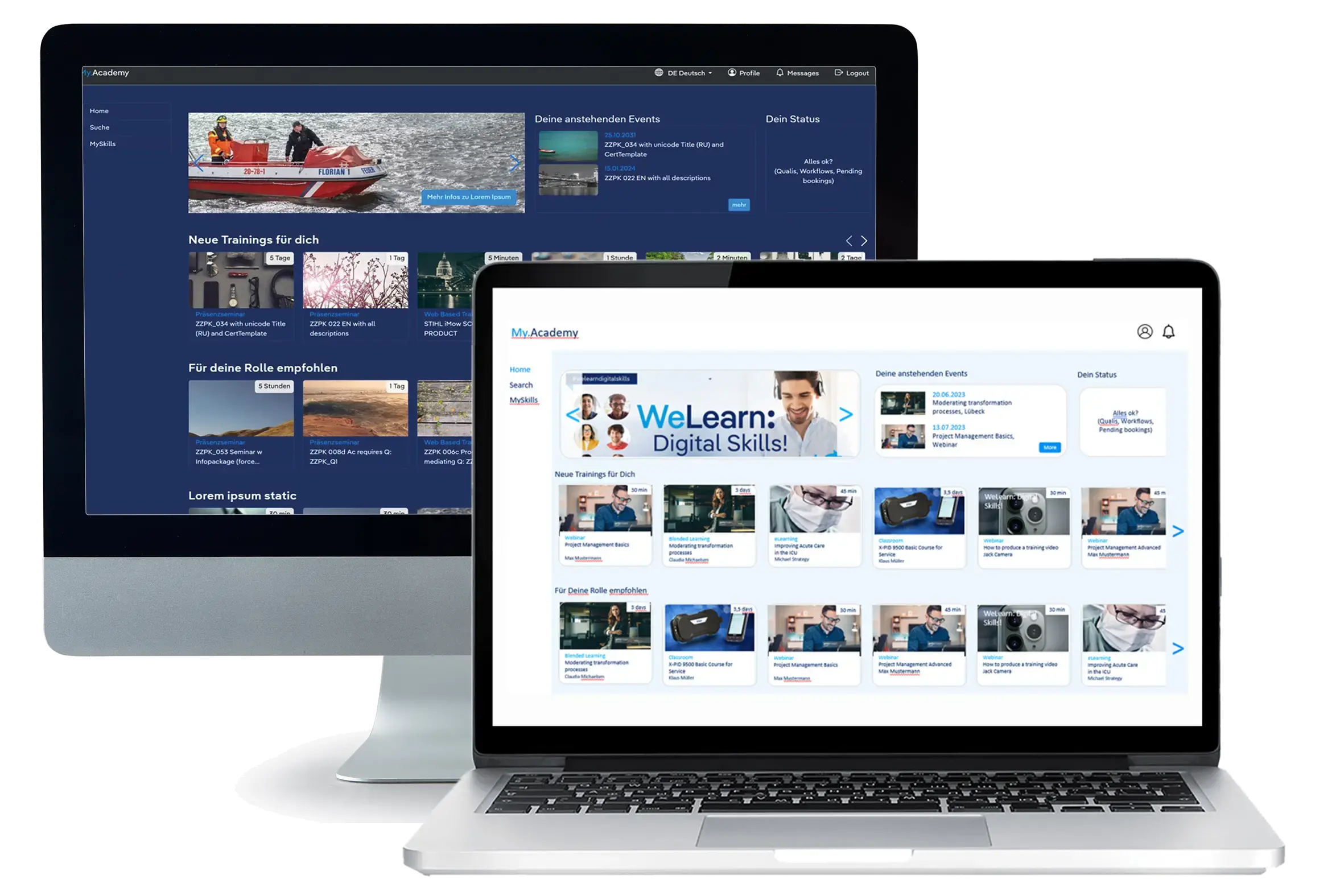Goals of Tracking Tools: SCORM, xAPI, and LTI
A modern learning platform must be flexible, scalable, and compatible with various e-learning standards. Companies, educational institutions, and trainers need tools that facilitate the creation, management, and analysis of learning content.
The goal is to offer customized learning paths, efficiently track progress, and generate comprehensive reports. SCORM, xAPI, and LTI are crucial interfaces that ensure interoperability between different systems, enable the integration of external learning resources, and capture learning activities.
1. What Are SCORM, xAPI, and LTI?

SCORM, xAPI, and LTI are the key standards in digital learning. They offer different approaches to integrating, managing, and analyzing learning content in modern educational environments.
While SCORM is primarily used for structuring and tracking e-learning courses, xAPI enables broader tracking of learning experiences beyond the traditional learning management system. LTI, on the other hand, facilitates seamless integration of external tools and resources into existing platforms.
Understanding these standards is essential to selecting the right tools and methods for an effective learning strategy.
SCORM (Sharable Content Object Reference Model)
SCORM is a standard for packaging, structuring, and tracking e-learning content. It enables the interoperability of learning content across different Learning Management Systems (LMS). SCORM-based content is stored in ZIP files (packages) containing course structure, learning objects, and metadata.
The platform reads these packages and tracks learner progress, such as whether a module is completed or which quiz questions were answered. Drawbacks include limited interaction capabilities, lack of mobile learning support, and restrictions on tracking complex learning experiences.

xAPI (Experience API)
xAPI significantly expands the capabilities of SCORM. It allows the capture of data on a wide range of learning experiences, even outside traditional LMS environments. Whether it’s simulations, mobile apps, or informal learning, xAPI collects and stores all interactions in a Learning Record Store (LRS).
This enables detailed analysis of learning behavior. xAPI can also map complex learning paths and track the transfer of knowledge into practice. The challenge lies in implementation, as integrating an LRS and structuring the data correctly can be complex.
LTI (Learning Tools Interoperability)
LTI enables the integration of external tools and resources directly into an LMS. Instead of managing separate logins or switching between platforms, learners can access web conferences, interactive content, or tools like Google Docs with a single click.
This simplifies usage and increases adoption. Technically, a secure connection is established between the LMS and the tool, facilitating data exchange and authentication. Drawbacks include dependencies on third-party tools and potential data privacy issues.
2. Comparison of the Standards
SCORM is ideal for formal learning in traditional LMS environments but offers only basic analysis and interaction capabilities.
xAPI is excellent for capturing and evaluating learning experiences in various contexts but is technically more challenging and requires a Learning Record Store (LRS).
LTI facilitates the integration of external tools but is less suited for tracking learning progress, as it focuses on tool linking rather than data collection.
3. Technical Requirements
SCORM: The LMS must support SCORM 1.2 or SCORM 2004. It should be capable of importing SCORM packages and tracking learning progress. An authoring tool (e.g., Articulate, Adobe Captivate) is also required to create SCORM content.
xAPI: Requires a compatible LMS that can send xAPI data, as well as a Learning Record Store (LRS) to receive and store this data. Additionally, content using xAPI must be connected to the LRS via an API.
LTI: The LMS must support the LTI specification (usually LTI 1.3). The external tools must also be LTI-compatible, and the correct configuration (client ID, deployment ID) must be set up in the LMS.
4. Platform Features and Functions
SCORM Support: Import and management of SCORM packages, detailed tracking (e.g., completed modules, scores). Ability to integrate quizzes, interactions, and tests directly into SCORM content.
xAPI Support: Integration of an LRS, capturing learning records from various sources (e.g., mobile apps, simulations, devices), ability to depict complex learning experiences and generate detailed reports.
LTI Integration: Easy connection of third-party tools such as Zoom, Microsoft Teams, or specialized applications. Support for SSO, allowing users to access these tools without re-authentication.
5. Use Cases and Examples
SCORM: Compliance training in companies where tracking learning progress and completing modules is mandatory. For example, a financial institution uses SCORM-based courses to ensure all employees understand the latest regulations.
xAPI: An automotive manufacturer uses xAPI to capture data from a VR simulation where employees practice assembling a new vehicle model. The data provides detailed insights into which steps were executed incorrectly and where targeted training is needed.
LTI: A university uses LTI to integrate Zoom webinars and external interactive math tools directly into its LMS. Students have seamless access to various learning resources without switching platforms.
6. Benefits and Value for Different Audiences
- Companies: Automated reporting and compliance tracking; integration of performance and learning analytics for deeper insights into training effectiveness.
- Trainers and Instructors: Easy tracking of learning activities and outcomes, the ability to customize and personalize learning content based on real data.
- Learners: Personalized learning paths, flexible access to content, improved learning experience through interactivity and multimodal learning resources.
7. Disadvantages and Challenges
SCORM: Limited flexibility in representing learning paths and experiences, no native support for mobile learning, outdated technology that captures only basic learning data.
xAPI: High implementation and data integration effort, requires specialized knowledge and infrastructure (e.g., LRS). Standardization is not as widespread as SCORM, which can limit adoption.
LTI: Technical dependence on third-party tools, limited control over data security. Potential compatibility issues with different LMS versions.
8. Best Practices for Integration
SCORM: Use established authoring tools to create SCORM packages; conduct regular tests to ensure compatibility with the LMS; structure learning modules clearly to provide learners with a logical learning journey.
xAPI: Define clear goals and a data structure before implementation; choose a reliable LRS that integrates seamlessly with the LMS; train developers to define xAPI statements accurately.
LTI: Ensure that all tools to be integrated support the latest LTI specification; perform regular security checks of the interfaces; consider data protection regulations when exchanging user data between the LMS and external tools.
9. Future of the Standards
SCORM is increasingly being supplemented or replaced by more flexible standards like xAPI. However, it remains relevant in areas that rely on formal, structured learning content.
xAPI will continue to gain importance, especially in the context of learning analytics and personalized learning. Future LMS solutions are expected to offer native xAPI support.
LTI is being expanded through the introduction of LTI Advantage, which offers new security and functionality enhancements. Seamless integration of various tools and the use of open standards will remain crucial for the acceptance of LMS in educational institutions.

10. FAQs and Myths About SCORM, xAPI, and LTI
- “Is SCORM dead?” – No, SCORM is still used in many companies, especially for compliance training. However, it is technologically limited and often complemented by more modern standards.
- “Can I use xAPI without an LRS?” – Technically yes, but the main advantages of xAPI – comprehensive analysis and storage of learning data – require an LRS to store and evaluate this information in a structured way.
- “Are LTI tools secure?” – Security depends heavily on the implementation and data protection policies of the respective tool. Careful selection and regular security checks are essential.
Checklist for Choosing the Right Tracking Technology
The following checklist helps you consider relevant aspects and choose the optimal tracking technology for your learning environment.

1. Define Goals and Requirements
- What types of learning content need to be tracked (e.g., formal e-learning, informal learning, simulations)?
- How detailed should the tracking of learning experiences be?
- What reports and analyses are required (e.g., completion rates, performance analysis, skill development)?
2. Compatibility and Integration
- Does the existing LMS support the desired standards (SCORM, xAPI, LTI)?
- Is a Learning Record Store (LRS) available or can it be integrated to capture xAPI data?
- Are there existing tools or external resources that need to be integrated via LTI?
3. Technical Infrastructure
- Are the technical requirements for the chosen technology met (e.g., support for SCORM 1.2/2004, LRS integration for xAPI)?
- How complex is the implementation of the interface (e.g., API connection, security configuration)?
- Are additional hardware or software resources needed?
4. Learning Formats and Scenarios
- Should the learning content be accessible on various devices (desktop, tablet, smartphone)?
- Is mobile learning or learning in different contexts a priority?
- Are interactive, simulation-based, or hands-on training sessions needed?
5. Data and Security Requirements
- What data needs to be collected and stored (e.g., personal data, performance data)?
- Are data protection and security requirements, such as GDPR, met?
- Are the data transferred and stored securely and encrypted?
6. Scalability and Flexibility
- Does the solution need to scale with an increasing number of users or content?
- How flexible is the technology for future expansions or modifications?
- Is there support for future standards and updates?
7. Costs and Budget
- What are the costs associated with the implementation and operation of the technology (e.g., licensing fees, support)?
- Are there additional costs for training developers or administrators?
- How does the cost-benefit ratio compare to other solutions?
8. User-Friendliness and Training Requirements
- How intuitive is the technology for administrators, trainers, and learners?
- Is it easy to create learning content (SCORM/xAPI) and integrate it into the LMS?
- Are training sessions needed for developers or users?
9. Reporting and Analytics Capabilities
- What types of reports are supported (e.g., completion reports, skill assessments, interaction reports)?
- Can reports be customized to meet the needs of different stakeholders (e.g., management, trainers, learners)?
- How easily can data be exported and further processed?
10. Support and Community
- Is reliable support provided by the vendor (e.g., technical support, documentation)?
- How large and active is the user community? Are there regular updates and new best practices?
- Are training sessions, webinars, or forums available for additional support?
Flexibility and Integration: Key Success Factors for Modern Learning Platforms
A flexible LMS and learning platform provider is essential for the success of e-learning programs. The needs of businesses and educational institutions are diverse and constantly evolving. To meet these demands, LMS and learning platforms must be capable of seamlessly interacting with various interfaces and external tools. Technologies like SCORM, xAPI, and LTI enable smooth integration of learning content, tools, and data.
Equally important is the ability to configure and adapt the platform to specific needs. This allows for the creation of customized learning paths, personalized learning experiences, and optimal support for all users. A provider that offers this level of flexibility not only meets current requirements but is also well-prepared for future developments.

About Us
Since 1998 SoftDeCC is working closely with major training centers and academies. This results in a unique experience with training requirements.
Our Learning Management System TCmanager® is designed to adjust to individual corporate learning processes and address evolving challenges. More about us ...

Free Consultancy
Discuss your Training Challenge with us.
Call +49 (0)89 / 309083930 to arrange for your free consultancy.
.webp)




